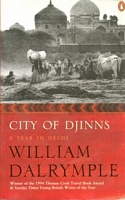Title: City of Djinns – A Year
in Delhi
Author: William Dalrymple
Publisher: Penguin,
2004 (First published 1993)
ISBN: 978-0-143-03106-2
Pages: 343
Dalrymple is an acknowledged
Indophile whose other books have also been reviewed earlier in this blog, like The
Last Mughal, The White Mughals and Nine Lives. He was born in
Scotland and is a fellow of the Royal Society of Literature and the Royal
Asiatic Society. Besides writing, Dalrymple has presented television
documentaries on Indian topics. His wife, Olivia Fraser is herself an artist
who has produced the remarkable illustrations adorning the pages of the book.
The couple now divide their time between London and Delhi.
The book is in essence what the
author saw and thought during his year-long stay in the Indian capital city in
1989-90. He borrows the concept of djinns (spirits said to have been
created from fire) from Muslim folklore to make the theme of the book, a
portrait of a city disjointed in time, a city whose different ages lay
suspended side by side as in aspic, a city of djinns (p.9). The author
peels through the thin layers of history surrounding the core of the city, the
recent ones first. Thus, the British presence is dealt with first, followed by
the struggle of the last of the mughals in 1857, consolidation of the British
during early 19th century, last remnants of Mughal structure in the
18th, Shah Jahan’s founding of the city during middle-17th,
Tughluk’s period during the sultanates, Prithvi Raj Chauhan, and into the mists
of pre-history, like Indraprastha and Hastinapura of Mahabharata. Each section
is amply made lucid by interactions with noted personalities from Delhi who has
made it their speciality of study.
Delhi enters prehistory through
the Mahabharata epic. The palace of the Pandavas, Indraprastha, was
situated there. Though archeologists differ about the scale of magnificence of
the Pandava structures, there is no denying, from excavated remains that a
civilization which has produced fine pottery known as painted grey ware,
has been flourishing along the coast of river Jamuna around 2800 years before.
After a long hiatus, Delhi again comes into the picture with Prithvi Raj
Chauhan who made the mistake of pardoning his Afghan enemy once in the war –
Mohammed of Ghor! He came back with a larger force the next year, defeated and
beheaded Chauhan in 1192, inaugurating six centuries of Islamic rule in the
city. The middle ages saw flashes of splendour echoing along the streets of
Delhi in the superb buildings made by emperor Shah Jahan. What we see in Old
Delhi is the remains of fine structures built by that megalomaniac
autocrat.
Shah Jahan was ousted from the
throne by his treacherous third son, Aurangzeb who declared war against the
country and its culture. Lot of temples were destroyed or desecrated resulting
in resentment throughout the empire. No wonder that the empire began to crumple
no sooner Aurangzeb died in 1707. The 18th century was an era of
palace intrigue, treachery, and degenerate morals. The British came on the
scene not much later, who gradually sunk their claws into the flesh of Islamic
society and mercilessly tore down the social order when it effectively crushed
the rebellion of 1857. Lutyens modelled a new city, New Delhi, which
remains the seat of power of the Indian government.
The book is eminently readable,
with its presentation of characters throughout the chapters in the form
ordinary Delhiites, like the landlord, the taxi driver, the Persian-language
professor and numerous such people. One thing which emerges from the treatise
is the helping mentality of the common people. It is not to be confused with
the normal mindset of the people, who will nevertheless be willing to extend a
helping hand to a foreigner staying amidst them. Dalrymple also displays an
aspect of Indian society – venality – which permeates all spheres of society,
be it politics, religion, social relations and administration. Indians must
take note of this disturbing fact, which keeps on churning to the top from the
writings of foreign authors, right from the 15th century Arab and
Portuguese travelers. Dalrymple just confirms the notion in a gentle,
apologetic way. The book is very humorous and is a delight to read. The section
in which the author dissects through newspaper advertisements for arranged
marriage is taking hilarity to new heights.
One downside which can be pointed out is that, as always,
Dalrymple caters to British sensitivities about India. There is no arguing that
the book appeals equally strong to the Indian reader, but a British one is more
at ease while reading it. The native reader experiences a whole panoply of
emotions like pride, curiosity, anticipation and even outright shame by going
through the work, the foreign one feel a sense of déjà vu – it simply reaffirms
what he had had already in his mind.
The book is strongly recommended.
Rating: 3 Star














































No comments:
Post a Comment